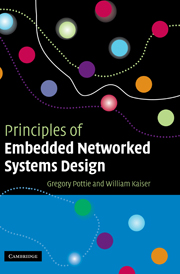Book contents
- Frontmatter
- Contents
- Preface
- Acknowledgments
- List of Abbreviations
- 1 Embedded network systems
- 2 Representation of signals
- 3 Signal propagation
- 4 Sensor principles
- 5 Source detection and identification
- 6 Digital communications
- 7 Multiple source estimation and multiple access communications
- 8 Networking
- 9 Network position and synchronization services
- 10 Energy management
- 11 Data management
- 12 Articulation, mobility, and infrastructure
- 13 Node architecture
- 14 Network data integrity
- 15 Experimental systems design
- 16 Ethical, legal, and social implications of ENS
- 17 Design principles for ENS
- Appendix A Gaussian Q function
- Appendix B Optimization
- Index
7 - Multiple source estimation and multiple access communications
Published online by Cambridge University Press: 10 August 2009
- Frontmatter
- Contents
- Preface
- Acknowledgments
- List of Abbreviations
- 1 Embedded network systems
- 2 Representation of signals
- 3 Signal propagation
- 4 Sensor principles
- 5 Source detection and identification
- 6 Digital communications
- 7 Multiple source estimation and multiple access communications
- 8 Networking
- 9 Network position and synchronization services
- 10 Energy management
- 11 Data management
- 12 Articulation, mobility, and infrastructure
- 13 Node architecture
- 14 Network data integrity
- 15 Experimental systems design
- 16 Ethical, legal, and social implications of ENS
- 17 Design principles for ENS
- Appendix A Gaussian Q function
- Appendix B Optimization
- Index
Summary
This chapter treats two related topics: detection and estimation of multiple sources, and the sharing of a communication medium among multiple users. In the former, knowledge of the statistical properties of the sources together with control of the layout of sensors can be used to achieve a degree of source separation. These techniques can also be applied in multiple access communications, but in addition the communicators can cooperate in terms of channel assignments and modulation type to make the task much easier. The chapter begins with a general discussion of interference models and mitigation methods before describing some source separation techniques. Then multiplexing methods for communications systems are discussed, before presentation of the effects of the available communication infrastructure and network topology on the choices of multiple access schemes. Adaptive power control is revisited from the point of view of its effect on the capacity of multiple access schemes.
Interference models
Interference is an unwanted signal sharing a channel being monitored, whether for sensing purposes or for communications. In contrast with thermal noise which is added in the receiver, interference is generally time-varying, e.g., another source or communicator. Moreover, it is confined to a particular band of frequencies, unlike Gaussian noise which is modeled as being uniform over the whole range of communication frequencies. If the interference is deliberate, it is termed jamming. In the design of systems that are potentially subject to jamming, the jamming is assumed to be of the worst possible form, i.e., energy is concentrated in such a way as to maximize error probability
- Type
- Chapter
- Information
- Principles of Embedded Networked Systems Design , pp. 195 - 228Publisher: Cambridge University PressPrint publication year: 2005



